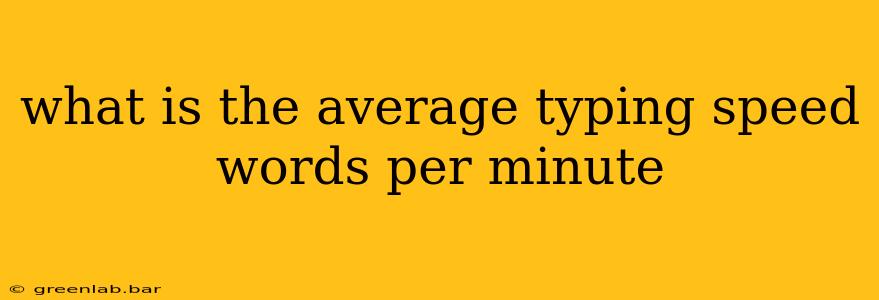Typing speed, measured in words per minute (WPM), varies significantly depending on factors like age, experience, and typing method. Understanding the average WPM and the factors that influence it is crucial for anyone looking to improve their typing skills. This article explores the average typing speeds across different groups and offers insights into how to boost your own WPM.
Average Typing Speeds: A Breakdown
There's no single definitive answer to the question, "What's the average typing speed?" The average WPM differs greatly depending on the population being considered. Here's a breakdown:
-
Beginner Typists (under 6 months experience): Expect speeds ranging from 5 to 20 WPM. Accuracy is often prioritized over speed at this stage.
-
Intermediate Typists (6 months - 1 year experience): Typing speeds typically fall between 20 and 40 WPM. Hunt-and-peck methods start to give way to more efficient touch-typing techniques.
-
Experienced Typists (over 1 year experience): These individuals often achieve 40 to 60 WPM, with some reaching even higher speeds through consistent practice and refinement of their technique.
-
Professional Typists/Data Entry Clerks: Professionals in roles requiring extensive typing often reach speeds of 60 WPM or more, sometimes exceeding 80 WPM. Their high speed is often coupled with exceptional accuracy.
-
Touch Typists: Individuals who practice touch typing – typing without looking at the keyboard – tend to have significantly higher WPMs than those who use the hunt-and-peck method. A skilled touch typist can easily exceed 60 WPM.
Factors Influencing Typing Speed
Several key factors contribute to variations in typing speed:
-
Experience: The more you type, the faster you'll become. Consistent practice is key to improving WPM.
-
Typing Method: Touch typing dramatically increases speed and accuracy compared to hunt-and-peck.
-
Keyboard Familiarity: Comfort and proficiency with your keyboard layout greatly affect typing speed.
-
Accuracy vs. Speed: While speed is important, accuracy is equally crucial. Focusing solely on speed can lead to errors. Striking a balance between speed and accuracy is essential for efficient typing.
-
Age: Younger typists may adapt more quickly and have faster reaction times.
-
Individual Differences: Natural aptitude, hand-eye coordination, and cognitive abilities all play a role.
Improving Your Typing Speed
Improving your WPM requires dedication and consistent effort. Here are some effective strategies:
-
Learn Touch Typing: Invest time in learning touch typing techniques. Numerous online resources and tutorials are available.
-
Practice Regularly: Consistent, even short, practice sessions are more effective than infrequent long ones.
-
Use Typing Tutor Software/Websites: Utilize online typing tutors to track your progress and receive personalized feedback.
-
Focus on Accuracy: Prioritize accuracy over speed, especially in the initial stages. Speed will naturally increase as accuracy improves.
-
Set Realistic Goals: Don't try to increase your speed too rapidly. Set achievable goals and gradually work towards them.
-
Maintain Proper Posture: Good posture reduces fatigue and improves typing efficiency.
-
Take Breaks: Regular breaks prevent fatigue and improve focus.
Conclusion: Aim for Improvement, Not Just the Average
While knowing the average typing speed provides context, the focus should be on continuous improvement. By understanding the factors that influence typing speed and employing effective practice strategies, you can significantly enhance your WPM and overall typing proficiency. Remember, the journey to faster typing is a marathon, not a sprint!

